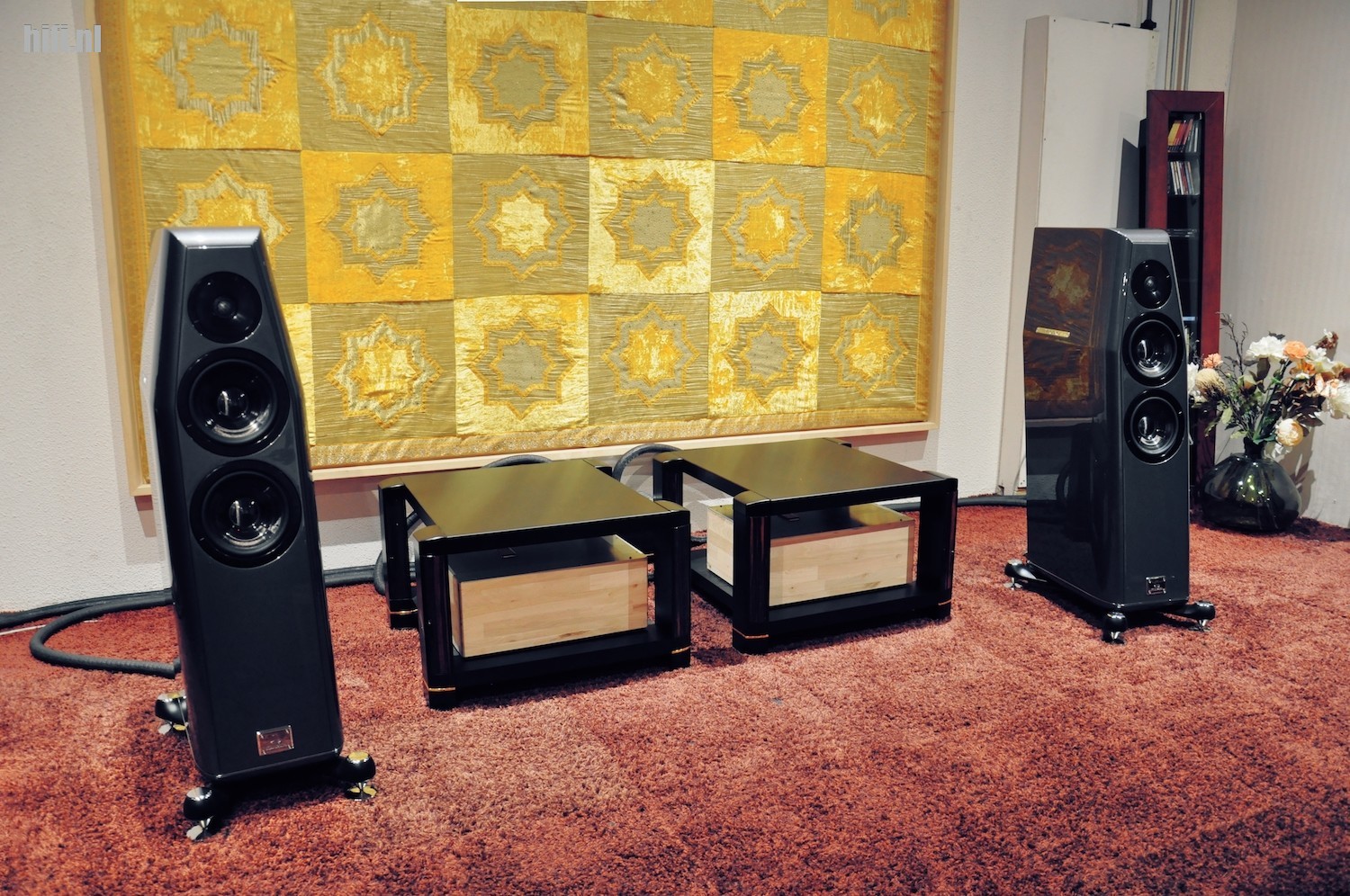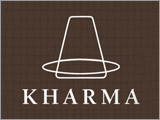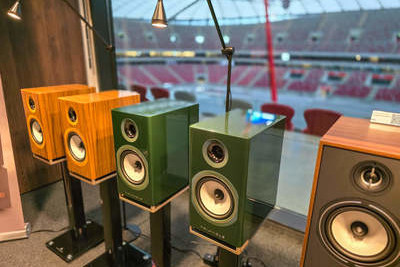
Would I fancy listening to the Kharma Elegance DB7 Signature-1.1 speakers for a review? You don't often get a question like that as a hi-fi reviewer. The world-renowned loudspeaker manufacturer from Breda, the Netherlands, had extended this invitation to HIFI.NL/.BE because they have added some new optional colors to their Elegance line, of which the DB7 model is a part. | Voor Nederlands, klik hier
Normally, 'a new color' is not a reason to review an existing product, but a useful justification was quickly found: the Signature version of the DB7 (now in version 1.1) was not yet available 11 years ago when I visited Breda. Back then I was listening to the newly introduced DB7 loudspeaker. In my glowing review I labeled them as 'the new touchstone', but with the arrival of the Signature version that qualification is most likely up for revision.
Kharma - A Not So Concise (nor entirely impersonal) History
When you say Kharma, you also say Charles van Oosterum. He founded OLS (Oosterum Luidspreker Systems) in 1982 to sell loudspeakers for DIY. But for Charles, who had been pulling loudspeakers from radios and successfully putting them in other enclosures since he was a kid, merely supplying existing DIY designs was not enough. OLS had to have their own loudspeakers, so first, the Emotion and Lotus series were created, and pretty soon after that came the Divine series and finally the Ceramique series. For that Ceramique series - as the name already implies - he was the first in the world to apply the extraordinary ceramic drivers from the German brand Thiel (now Accuton) in a DIY design. By the way, yours truly was already a customer of OLS at the time, but I had to limit my budget to a design based on KEF units that were still sold separately at the time. My speakers were the giant PL301s - which to this day are playing sweet music at a good friend's place.

But of course, my ears were telling me a different truth. Every time I visited Breda, I also slipped into the listening room where the Ceramique's were set up. One day, I promised myself, I would own a pair. Eventually, I managed to raise the necessary funds and bought a pair of Ceramique’s, featuring a modular housing of three cabinets per side. I had them spray painted in demi-matte Night Blue, and kept the crossovers outside the speaker enclosure (I mounted them on the wall next to the loudspeakers, with the components on an open board for "modification purposes").
OLS and Kharma
That's where this history ends for me because I still play with those loudspeakers, but for OLS it just started around that time. The Ceramique series turned out to be so good that Charles decided to take a different course with his business. While he continued to serve the Dutch DIY market through OLS, in 1993 he founded Kharma, which catered to the international market. No longer with kits, but with finished loudspeakers of very high quality. The legend was born.
The name Kharma is derived from "Karma," the Eastern mystical philosophy that all the effort and energy you invest in something will come back to you. Which continues to be the main principle behind all of Charles' designs, a respectable number by now. Currently, in addition to the Elegance line, the Kharma line-up features the Exquisite series and the Enigma Veyron series. All of them are still made entirely by hand, and still all made in Breda. Charles' progressive design philosophy and his drive and perseverance have certainly paid off. The name Kharma has earned respect all over the world, and its designs have won many awards. Not bad for a hifi company of Dutch origin.
Elegance DB7-1.1 Signature - Technology
The model name DB7 stands for Double Bass, 7 inches. It is a two-way system with a dual bass driver in a beautifully finished, slightly backward-sloping, ported enclosure. At the time of its introduction, the "regular" DB7 was part of the first series of Kharma loudspeakers that no longer used Accuton ceramic drivers. Charles believed he had managed to get the maximum out of those drivers, but that his designs had more potential. To this end, he developed a new driver of his own, the revolutionary Kharma Composite Driver (KCD) with a patented super lightweight cone made of carbon fiber and resin, which has an optimized shape based on Finite Element analysis. The tweeter in the Elegance series features a 1-inch dome made of beryllium, a very lightweight and rigid metal that does not distort within the audible frequency spectrum. The results were astounding. While the DB7 did not "completely destroy" (a popular expression among audiophiles) the Kharma Ceramique CRM-3.2E, which I had reviewed shortly before, it definitely outperformed it in all areas.
Right, so much for the normal DB7, now what exactly does the Signature upgrade entail? It consists of four steps. First of all, the Kharma Composite Driver is replaced by a Kharma Omega-7 driver. This has an improved cone constructed from Ultra High Modulus carbon fibers and a unique resin, with a shape that has been further optimized by 'Finite Element' analysis. As a result, it is even lighter and stiffer, and the minimal distortion that remains therefore lies even further outside the audible frequency spectrum. In addition to the Omega-7 driver, the Signature treatment includes application of better internal acoustic absorption material and better and thicker cabling between the crossovers and drivers. And last but not least, the crossover and bass pipe, which are mounted on the rear panel of the loudspeaker, are treated with an advanced damping material that virtually eliminates mechanical resonances.
Listening to the Kharma Elegance DB7-1.1 Signature
The speakers were set up in Kharma's central listening room. A tastefully decorated space estimated to be about 40 square meters in size, both discreetly and visibly furnished with acoustic treatments that eliminate room acoustics from the soundstage as much as possible. I have been familiar with this room for years, and it "feels" extremely natural. The speakers were painted in sublime high-gloss 'Gunsmoke Grey' paint. A very nice extension of the optional color palette, in addition to the high-gloss black and aubergine in which the Elegance models have been available from the beginning. Any color is possible on request and at an additional charge; metallic, high gloss or matte, or everything in between.
The audio system I would be listening to had undergone a major change since my previous review. A dCS Bartok streamer served as the source, into the Exquisite P1000 preamplifier, which drove the prototype of a new Enigma Veyron power amplifier. The interconnects were Kharma Signature level, and the speaker cables and power cords were from the top-of-the-line Enigma Veyron series. Truth be told, I would be the first to admit that while my memory for sound is reasonably well-trained, there is no way I can remember the finer nuances of a review I did 11 years ago. This is why I brought some of the tracks that I played back then, along with my listening notes and the final review from the original DB7 listening session.

To warm up the hearing, I listened to those tracks first. And although I realized that the comparison was flawed anyway because of the updated audio system, I found the differences - based on my notes from back then - remarkable. The sound had a degree of transparency and smoothness the likes of which I have rarely heard, not even back then. The bass was very deep and extremely detailed, the rendition of voices was incredibly expressive and colorful, and the treble was truly sublime and silky smooth. More than anything, however, it was the spatial image that amazed me. This also became apparent during the first track of the actual listening session. On his live album East/West, Bill Frisell plays an exciting interpretation of Heard It Through The Grapevine. The texture of the strings was fantastic, I could hear every touch of the instruments, down to the smallest details, in a very wide and transparent spatial image. The bass was very deep and completely in balance with the music, something you might not expect from a speaker this size.
The same thing happened when I listened to the track Alma Venis, from the album Distare Sonanti by Giovanni di Domenico, Arve Henriksen, and Tatsuhisa Yamamoto. Their improvised avant-garde jazz music tells an extremely compelling story that irresistibly pulled me in. The build-up of tension in this track is powerful, and a huge, layered, and occasionally even three-dimensional image was projected into the listening room with playful ease. The older but natural-sounding recording technique used for Sweet and Pungent, a track on the great MoFi-remaster of Duke Ellington's Blues In Space album, gave the music a wonderful flow, and Booty Wood's trombone solo had a lustrous and stunningly natural sound. I was about to say "for a 1960 recording" but apparently age doesn't matter much at this level of playback.
Details, details
The Elegance DB7-1.1 Signature is very transparent but not at all ruthless. The thing with high-end speakers that I sometimes struggle with is that I find them too honest, and maybe even a little harsh. They may sound fantastic with audiophile recordings, made especially for high-end audio systems, but with 'normal music' there is little left of the experience. That is why I make a distinction between detail and transparency more and more often. As a manufacturer, you can create detail, for example by leaning your tonal balance a little towards the treble, but I often find this fatiguing after a while. Transparency is much more challenging. It is a quality that results from the combination of an above-average control - or even in-house development - of the applied technology, extensive measuring and understanding of how your product performs, the use of only the very best components and raw materials, and a highly developed ear for natural sound. You can't fake that.
If the playback is as transparent as that of the DB7-1.1 Signature you will hear details that don't come out that well on other systems. The track Nobody Here by Tunng, from their album Songs You Make At Night, begins with the sound of a rain shower. On a detailed system, you can hear all the drops individually, but on this transparent system, I could actually ’see' the difference between large and small drops. I also heard a very wide range of 'wet' and 'dry' sounds in the mix. By which I mean the amount of reverb. Each element in this bizarre mix had a different spatial manifestation. A somewhat unusual artistic choice that did, however, make it an extremely intriguing listen. The wacky break around 3'10, which almost knocked me over, was extremely spacious and various sounds playfully swirled around me. A lot of magic was used in the studio and that resulted in a delightfully alienating effect. Again, the soundstage was completely disconnected from the speakers, it was expansive and layered, and there was unexpectedly deep bass rumbling out from somewhere in the far background, deep and sonorous.
Yet more details
I want to highlight two more tracks from the many I listened to before I jump to conclusions. The first is by the French group Man. On their album Helping Hand, these psychonauts play delightfully hesitant avant-garde pop with a hint of improvisation. In the track Strange Feeling, the emphasis lies mainly on atmosphere, which they managed to create very nicely with the sound of an accordion in the very deep background. Once again the system established a rock-solid illusion of space, and the very deep rhythmic bass pulse that seemed to appear out of nowhere at about 3.10’ had punch and heft but did not pressurize the eardrums in an annoying way. Again, extremely transparent. The wonderful thing about this kind of sound is that you can distinguish all separate elements of the mix without losing track of their coherence. Small details remained perfectly audible, adding nearly tangible markers to the cloud of sound that the speakers projected into the room.
One of the most extreme recordings to experience that phenomenon, I think, is Keith Freund's Mont Baron, on his extraordinary album Constant Comments. This track begins with the sound of children playing outside. With my eyes closed, the sounds were all around me, even behind me, as if I had become part of the scene. At some point, a car appears to approach from the right, honking its horn, and it sounded so lifelike that I was tempted to pull my feet back so it wouldn't run over my toes. This whole album, by the way, is full of environmental sounds that make it an adventurous, almost cinematic listening experience. Freund is a master of mixing music with this kind of familiar sounds. Like the surf that appears to be washing around your ankles in Deep Shit Sunburn, or the lively swimming pool scene in the background of Eye Colorism. The zoo sounds - and a brief kitchen table conversation between a man and a woman - in The Ortzi, or the raindrops rattling on a car roof in For Broke/Everything Is Real. It sounded almost like a radio play, certainly more than just music, constantly sparking an irresistible curiosity about what other things the album would surprise me with.

The Kharma speakers seem to be made for this kind of ‘virtual surround' playback. The vastness of the spatial projection was truly astounding, without causing a gap in the center of the sound stage. Another very rare phenomenon that I was able to experience - to my delight - was that this audio system seemed to slow down time. I was drawn so deeply into the sound that the here and now faded into the background, and everything seemed to last much longer than in reality.
An 8-minute track lasted almost indefinitely in the parallel universe created by the music. That "time machine" feeling is the most important aspect of music reproduction as far as I'm concerned. And this sublime system with the Elegance DB7-1.1 Signature loudspeakers didn't stand in the way of that.
The Bottom Line
The Kharma Elegance DB7-1.1 Signature does not come cheap. But it is a truly fantastic loudspeaker. Their tremendous coherence in phase and timing enables an astonishingly large and stable spatial image that incorporates all the elements of the mix, almost tangible and at a level of tonal reality you will only find in products made by a select group of high-end manufacturers who have thought about every detail. That palpability, where every element of the music has its own shape, color, and texture, is exclusive to a category of high-end that makes no compromises and thus demonstrates - to the extreme - what electro-mechanical music reproduction is capable of. The emotional engagement I felt when listening to this system was profound and genuine. Because my brain was not too heavily involved in making sense of everything I heard, there was more room for amazement and admiration.
And then there is that matter of 'the touchstone'. Well, I guess the account of my musical journey leaves little room for speculation. I have become a lot more careful with absolutisms over the years. After all, I cannot possibly listen to everything on the market. But the Elegance DB7-1.1 Signature ticked so many boxes that I cannot think of anything else in this price range that comes close. And I can only confirm this with a score of 5 out of 5 stars and a well-deserved Recommended Award.
Kharma Elegance DB7-1.1 Signature
27.500 euros per pair | www.kharma.com
Rating 5 / 5






